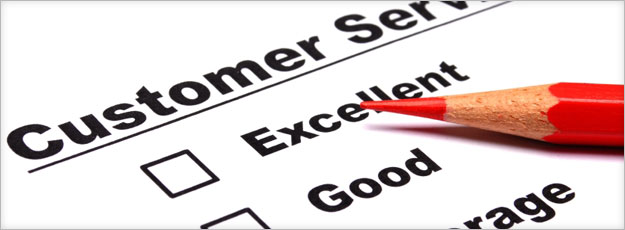Playing for Keeps: 11 Ways to Create Customers for Life
August 2011
By The Author
Reality check: You’re not special.
Here’s a cold, harsh truth about business growth and the nature of competition: Your products and services are not unique. There are plenty of other choices out there, and thanks to modern search engines, finding those options can be done in a fraction of a second.
“But wait!” you protest, “We are the only company that offers this product with this particular combination of features at this exact price!”
As accurate as that statement might be, your customers don’t have the time or the desire to keep track of all those finer points. You live and breathe the details of your business; your customers do not. They know that you sell widgets and your competitors sell widgets. To them, one widget is the same as the next, and one widget provider is just as good as another until proven otherwise.
So how do you not only create a preference for your widget but cultivate an unyielding loyalty to your company as the only one they want to be in the widget business with?
The answer has much less to do with convincing your customers that your widgets are special and irreplaceable and much more to do with convincing your customers that they themselves are special and irreplaceable.
Nothing erodes the relationship between a customer and a company faster than when that customer feels unappreciated. If they perceive that you don’t care about their business, they’ll happily buy their widgets elsewhere.
On the other hand, if you recognize that your customers are your company’s strongest asset and treat them accordingly, your brand will become as indispensable to them as they are to your brand.
Here are 11 ways to create customers for life:
1. Reach out and touch someone.

The process of winning a new customer is like dating. Everyone puts their best foot forward, and there’s lots of wooing and romance involved in sealing the deal.
After the sale closes, the shine can fade from the relationship a bit. Your focus turns to the coal-shoveling work of fulfilling your agreement, and the niceties of your courtship period tend to fall by the wayside.
However, if the only time your customers hear from you is when you’re trying to sell them something or when you’re trying to collect payment for your services, they’ll know exactly where they stand with you, and they won’t think twice about taking a call from your competitor who’s willing to pull out all the stops to steal them away.
Be proactive in your customer service efforts and make personal contact with your clients at least a few times a year. Don’t just sit back and wait for them to call you, and don’t assume that if you don’t hear from them that everything is peachy keen. Reach out to them, ask how they’re doing, feel out their level of satisfaction with your products or services and be a sounding board for questions, complaints or feedback.
By taking the initiative, you’re demonstrating that their value to your company goes far beyond their signature on a contract.
2. Put a human face on your brand.

Even in today’s mile-a-minute, everything-on-demand world of automation and convenience, one simple fact remains unchanged: people want to do business with people.
As a result, one of the most effective ways to make doing business with your company a pleasure through and through is to give your customers one point person who will take ownership of ensuring that their every need and concern is addressed.
There’s nothing more aggravating to a client than being passed from one person to another when they’re trying to get the answer to a question or resolution to a problem. When this happens, it’s easy for the customer to become angry and disenchanted with what they perceive to be a faceless brand and simply give up and go elsewhere.
However, you can save them the trouble of finding a new provider while simultaneously repairing the relationship if have the right customer service structure in place. Potentially deal-breaking issues can be easily resolved when there’s a real, knowledgeable human being on the other end of the phone or email who has a name, a face and a passion for providing a swift, helpful response.
3. Create a culture of service.

If you’re really serious about cultivating long-lasting relationships with your clients, customer service can’t be relegated to a policy manual or a department. It has to be an integral part of your company’s DNA.
Every single person within your organization is in sales, and every single one of them is in customer service, too. Like CEO Tony Hsieh has said on many occasions, Zappos is a service company that happens to sell shoes.
From the receptionist at the front desk to the junior-level guy behind the scenes doing the work that your clients will never see to the accountant that generates the invoices, each action and decision that these individuals make has a cumulative effect in defining your brand.
The key to creating a culture of service that permeates every level of your organization is empowerment, which means you need employees to whom you can entrust this level of responsibility.
Take great care with every hiring decision and seek out individuals who understand the importance and value of their role in shaping your customers’ experience of your brand. Most people can be trained in the nuances of a specific job role, but there’s no orientation program that can instill charisma and work ethic where it does not exist.
Passion is contagious. When your employees project genuine enthusiasm for their job and take ownership of providing the highest caliber service, your customers will feel that they’re more than just a number on a spreadsheet.
4. Reward good behavior.

If you find yourself constantly discounting your products or services to keep your customers coming back for more, you’re training them to love your brand based on price alone. Coupons and sales offer your customers a one-time benefit, and their appreciation for such concessions is as short-lived as the promotion itself.
Your marketing efforts should increase the perceived value of your goods or services, not undercut them. Rather than sacrificing your bottom line to reel in bargain hunters, why not incentivize your best customers to continue doing they’re already doing?
Developing a customer loyalty rewards program – whether it’s based on the longevity of their relationship with you, how much they’ve spent or how many referrals they’ve sent your way – is a great way to reinforce behaviors and actions that help to advance their relationship with your brand.
The key is structuring the program so that the reward is something that holds value to your customer, the initial payoff is attainable within a few months of participation and redemption is an easy, hassle-free process; otherwise, your loyalty program will have exactly the opposite effect.
5. Ask, listen and respond.

Soliciting feedback is a win-win customer relations strategy: it’s an easy way to demonstrate that you care about their needs and desires, and in return, you get valuable insights straight from the source.
After all, who has a clearer view of the ways you could potentially improve what you do or what you have to offer like the customers who use your products or services day in and day out?
In addition to proactively requesting input from your customers, it’s also important to monitor what they’re saying about you. Make sure to keep tabs on your reviews on sites like Google Places and Yelp, and use tools like Google Alerts and Social Mention to stay on top of the conversations that are occurring around your brand across the blogosphere and social media networks.
Certainly you can’t change the course of your business to meet the whim of every customer. But if you see certain requests being made repeatedly, that’s a red flag that there are prime opportunities waiting to be seized to create more robust relationships between your business and your customers.
6. Be one with your tribe.

Take a genuine interest in your customers and their well-being beyond the depth of their pockets.
Keep tabs on key developments in their world and celebrate milestones with them. Give them a shout-out on Facebook or Twitter to acknowledge their accomplishments and help them spread the word.
If your client maintains a blog, follow their posts, share great articles that they publish with your own network and leave thought-provoking comments that spark further discussion or debate.
If a customer comments on your blog or Facebook page, by all means, make sure you respond. When they take the time to actively engage with you, don’t ignore their advances, or they won’t bother to continue.
These small gestures will cost you little time and no money, but they show in a big way that you’re paying attention to the things that matter most to your customers and that you’re invested in their success.
7. Help them advance their goals.

Always have your antenna up for opportunities to help your customers in ways that go beyond your direct product or service offering.
For example, you could call their attention to an insightful article that pertains to an issue of interest to their business. Share links to their blog posts with your fans and followers. Send good job candidates their way. Look for chances to make connections between your clients to facilitate networking and mentoring. Make referrals on their behalf as often as you can.
All of these actions demonstrate to your customers that they’re constantly on your radar and that you’re a true business partner and not just another widget seller.
8. Practice random acts of gratitude.

It’s standard practice to send tokens of appreciation to your customers around the Christmas holidays. This is always a nice gesture, but it’s not exactly mind-blowing.
Don’t make your customers wait 12 months for a demonstration of your gratitude. Do unexpected things throughout the year to show them how much their business means to your company.
You don’t have to break the bank to do something that leaves an impression; it truly is the thought that counts. For example, in today’s instant-gratification-seeking, social media-obsessed culture, think about how great an impact a simple, handwritten note of thanks from the CEO of your company could make.
9. Strive for perfection.

Each and every encounter between your customers and your company plays a role in defining your brand. Take the time to map out every opportunity or instance where your customers do or should come into contact with your business and look for ways to ensure that the experience you offer them is truly remarkable. How can you make it easier, faster, more convenient, more effective, more efficient, more valuable?
Bring everyone in your company together, and ask for their feedback. What tools can you give them to help them serve your customers better? Allow them to be candid about what they see as vulnerabilities and weak points. If there are cracks in the foundation, your customers will notice, so be proactive and aggressive in addressing any issues and ensuring that everything – from the integrity of your products and services to the quality of day-to-day interaction with your employees to the resolution of your customers’ problems or complaints – reflects an unwavering commitment to delivering nothing but the best possible experience.
10. Be honest.

While you should always strive for perfection, any organization run by human beings will inevitably make human mistakes. And in truth, your customers don’t expect you to be infallible 100 percent of the time. They do, however, need to know that they can count on you to make it right.
When problems arise, you have a real opportunity to step up to the plate. Be honest, be humble, be apologetic. Make sure that your actions show that the mistake was an honest one and that you’re sincere in wanting to right the wrong.
If you’ve built a reputation for quality and service, your customers will almost always be willing to forgive a small misstep, as they’ll know it’s the exception and not the rule. In fact, according to a recent Harris Interactive study, 63 percent of respondents said they would go back to a company after a negative experience if they received a follow-up apology or correction from a person in charge.
While you can’t always be perfect, you can always be honest. Transparency is the key to maintaining a solid foundation of trust that is the cornerstone of every long-term customer relationship.
11. Never stop selling.

Genuine customer loyalty must be earned one interaction at a time. You must approach every phone call, every email and every personal encounter like a sales opportunity, not because you’re constantly pushing something else at them but because you must continuously resell yourself and build a case for why you’re the one who can make their lives better and to whom they should entrust their precious dollars.
Happy customers not only keep the cash flowing, they’re your best prospects for additional sales and a vital source of referrals and word-of-mouth marketing.
If you put these principles into practice, you can transform your brand into one of the coveted elite few who have passionate, loyal, vocal customers who not only continue to buy but who do the job of selling for you. Customers who love companies love helping them grow.
Great authors are defined by their ability to set fire to the written word. All too often in today's digital information age, that creative spark is stifled, leaving the Web littered with content that is lifeless and ineffectual. Fame Foundry's Author has made it his mission to revive the act of writing as an art form, harnessing the power of language to command attention and ignite a following. It's the difference between telling a story and building a legend.